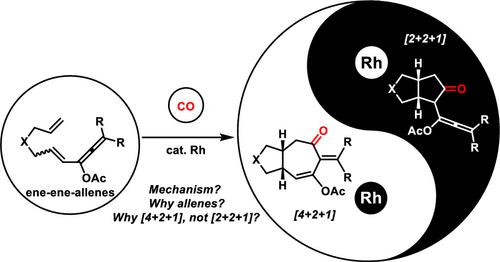当前位置:
X-MOL 学术
›
J. Org. Chem.
›
论文详情
Our official English website, www.x-mol.net, welcomes your feedback! (Note: you will need to create a separate account there.)
Why [4 + 2 + 1] but Not [2 + 2 + 1]? Why Allenes? A Mechanistic Study of the Rhodium-Catalyzed [4 + 2 + 1] Cycloaddition of In Situ Generated Ene–Ene–Allenes and Carbon Monoxide
The Journal of Organic Chemistry ( IF 3.6 ) Pub Date : 2022-07-29 , DOI: 10.1021/acs.joc.2c00406 Yusheng Yang 1 , Zi-You Tian 1 , Chen-Long Li 1 , Zhi-Xiang Yu 1
The Journal of Organic Chemistry ( IF 3.6 ) Pub Date : 2022-07-29 , DOI: 10.1021/acs.joc.2c00406 Yusheng Yang 1 , Zi-You Tian 1 , Chen-Long Li 1 , Zhi-Xiang Yu 1
Affiliation

|
Transition metal-catalyzed [4 + 2 + 1] cycloaddition of in situ generated ene/yne–ene–allenes (from ene/yne–ene propargyl esters) and carbon monoxide (CO) gives the [4 + 2 + 1] cycloadducts rather than [2 + 2 + 1] cycloadducts. Investigating the mechanism of this [4 + 2 + 1] reaction and understanding why the [2 + 2 + 1] reaction does not compete and the role of the allene moiety in the substrates are important. This is also helpful to guide the future design of new [4 + 2 + 1] cycloadditions. Reported here are the kinetic and computed studies of the [4 + 2 + 1] reactions of ene–ene propargyl esters and CO. A quantum chemical study (at the DLPNO-CCSD(T)//BMK level) revealed that the [4 + 2 + 1] reaction includes four key steps, which are 1,3-acyloxy migration (rate-determining step), oxidative cyclization, CO migratory insertion, and reductive elimination. The allene moiety in the substrates is critical for providing additional coordination to the rhodium center in the final step of the catalytic cycle, which in turn favors the reductive elimination transition state in the [4 + 2 + 1] rather than in the [2 + 2 + 1] pathway. The CO insertion step in the [4 + 2 + 1] reaction, which could occur through either the UP (favored here) or DOWN CO insertion pathway, has also been deeply scrutinized, and some guidance from this analysis has been provided to help the future design of new [4 + 2 + 1] reactions. Quantum chemical calculations have also been applied to explain why [4 + 2] and [4 + 1] cycloadditions do not happen and how trienes as side products for some substrates are generated.
中文翻译:

为什么是 [4 + 2 + 1] 而不是 [2 + 2 + 1]?为什么是艾伦?原位生成的烯-烯-丙二烯和一氧化碳的铑催化 [4 + 2 + 1] 环加成机理研究
过渡金属催化的 [4 + 2 + 1]原位环加成生成的烯/炔-烯-丙二烯(来自烯/炔-烯炔丙基酯)和一氧化碳 (CO) 得到 [4 + 2 + 1] 环加合物,而不是 [2 + 2 + 1] 环加合物。研究这种 [4 + 2 + 1] 反应的机理并理解为什么 [2 + 2 + 1] 反应不竞争以及丙二烯部分在底物中的作用很重要。这也有助于指导新的 [4 + 2 + 1] 环加成的未来设计。这里报道的是烯-烯炔丙基酯和 CO 的 [4 + 2 + 1] 反应的动力学和计算研究。量子化学研究(在 DLPNO-CCSD(T)//BMK 水平)表明 [4 + 2 + 1]反应包括四个关键步骤,即1,3-酰氧基迁移(速率决定步骤)、氧化环化、CO迁移插入和还原消除。底物中的丙二烯部分对于在催化循环的最后一步为铑中心提供额外的配位至关重要,这反过来有利于 [4 + 2 + 1] 中的还原消除过渡态,而不是 [2 + 2 + 1] 途径。[4 + 2 + 1] 反应中的 CO 插入步骤,可能通过 UP(此处偏爱)或 DOWN CO 插入途径发生,也已被深入审查,并提供了该分析的一些指导以帮助新的 [4 + 2 + 1] 反应的未来设计。量子化学计算也被用于解释为什么 [4 + 2] 和 [4 + 1] 环加成不发生以及如何生成三烯作为某些底物的副产物。这反过来有利于[4 + 2 + 1]而不是[2 + 2 + 1]途径中的还原消除过渡态。[4 + 2 + 1] 反应中的 CO 插入步骤,可能通过 UP(此处偏爱)或 DOWN CO 插入途径发生,也已被深入审查,并提供了该分析的一些指导以帮助新的 [4 + 2 + 1] 反应的未来设计。量子化学计算也被用于解释为什么 [4 + 2] 和 [4 + 1] 环加成不发生以及如何生成三烯作为某些底物的副产物。这反过来有利于[4 + 2 + 1]而不是[2 + 2 + 1]途径中的还原消除过渡态。[4 + 2 + 1] 反应中的 CO 插入步骤,可能通过 UP(此处偏爱)或 DOWN CO 插入途径发生,也已被深入审查,并提供了该分析的一些指导以帮助新的 [4 + 2 + 1] 反应的未来设计。量子化学计算也被用于解释为什么 [4 + 2] 和 [4 + 1] 环加成不发生以及如何生成三烯作为某些底物的副产物。并提供了该分析的一些指导,以帮助未来设计新的 [4 + 2 + 1] 反应。量子化学计算也被用于解释为什么 [4 + 2] 和 [4 + 1] 环加成不发生以及如何生成三烯作为某些底物的副产物。并提供了该分析的一些指导,以帮助未来设计新的 [4 + 2 + 1] 反应。量子化学计算也被用于解释为什么 [4 + 2] 和 [4 + 1] 环加成不发生以及如何生成三烯作为某些底物的副产物。
更新日期:2022-07-29
中文翻译:

为什么是 [4 + 2 + 1] 而不是 [2 + 2 + 1]?为什么是艾伦?原位生成的烯-烯-丙二烯和一氧化碳的铑催化 [4 + 2 + 1] 环加成机理研究
过渡金属催化的 [4 + 2 + 1]原位环加成生成的烯/炔-烯-丙二烯(来自烯/炔-烯炔丙基酯)和一氧化碳 (CO) 得到 [4 + 2 + 1] 环加合物,而不是 [2 + 2 + 1] 环加合物。研究这种 [4 + 2 + 1] 反应的机理并理解为什么 [2 + 2 + 1] 反应不竞争以及丙二烯部分在底物中的作用很重要。这也有助于指导新的 [4 + 2 + 1] 环加成的未来设计。这里报道的是烯-烯炔丙基酯和 CO 的 [4 + 2 + 1] 反应的动力学和计算研究。量子化学研究(在 DLPNO-CCSD(T)//BMK 水平)表明 [4 + 2 + 1]反应包括四个关键步骤,即1,3-酰氧基迁移(速率决定步骤)、氧化环化、CO迁移插入和还原消除。底物中的丙二烯部分对于在催化循环的最后一步为铑中心提供额外的配位至关重要,这反过来有利于 [4 + 2 + 1] 中的还原消除过渡态,而不是 [2 + 2 + 1] 途径。[4 + 2 + 1] 反应中的 CO 插入步骤,可能通过 UP(此处偏爱)或 DOWN CO 插入途径发生,也已被深入审查,并提供了该分析的一些指导以帮助新的 [4 + 2 + 1] 反应的未来设计。量子化学计算也被用于解释为什么 [4 + 2] 和 [4 + 1] 环加成不发生以及如何生成三烯作为某些底物的副产物。这反过来有利于[4 + 2 + 1]而不是[2 + 2 + 1]途径中的还原消除过渡态。[4 + 2 + 1] 反应中的 CO 插入步骤,可能通过 UP(此处偏爱)或 DOWN CO 插入途径发生,也已被深入审查,并提供了该分析的一些指导以帮助新的 [4 + 2 + 1] 反应的未来设计。量子化学计算也被用于解释为什么 [4 + 2] 和 [4 + 1] 环加成不发生以及如何生成三烯作为某些底物的副产物。这反过来有利于[4 + 2 + 1]而不是[2 + 2 + 1]途径中的还原消除过渡态。[4 + 2 + 1] 反应中的 CO 插入步骤,可能通过 UP(此处偏爱)或 DOWN CO 插入途径发生,也已被深入审查,并提供了该分析的一些指导以帮助新的 [4 + 2 + 1] 反应的未来设计。量子化学计算也被用于解释为什么 [4 + 2] 和 [4 + 1] 环加成不发生以及如何生成三烯作为某些底物的副产物。并提供了该分析的一些指导,以帮助未来设计新的 [4 + 2 + 1] 反应。量子化学计算也被用于解释为什么 [4 + 2] 和 [4 + 1] 环加成不发生以及如何生成三烯作为某些底物的副产物。并提供了该分析的一些指导,以帮助未来设计新的 [4 + 2 + 1] 反应。量子化学计算也被用于解释为什么 [4 + 2] 和 [4 + 1] 环加成不发生以及如何生成三烯作为某些底物的副产物。



























 京公网安备 11010802027423号
京公网安备 11010802027423号